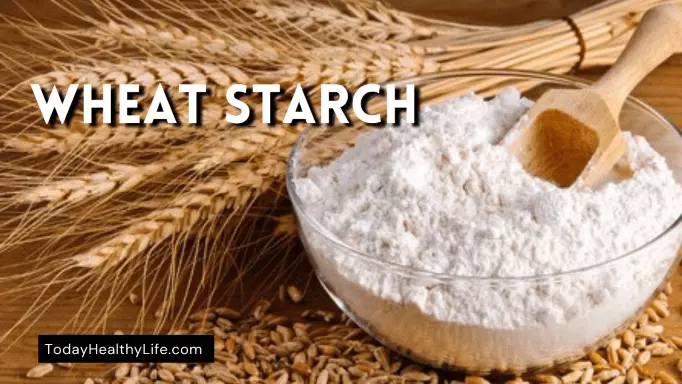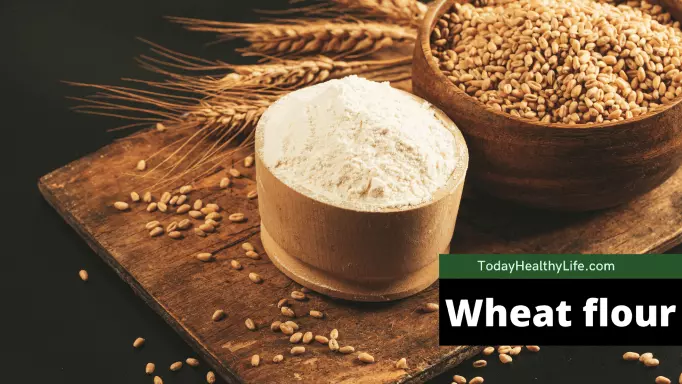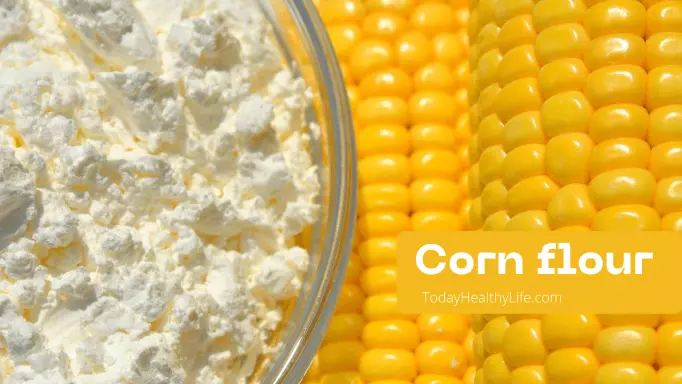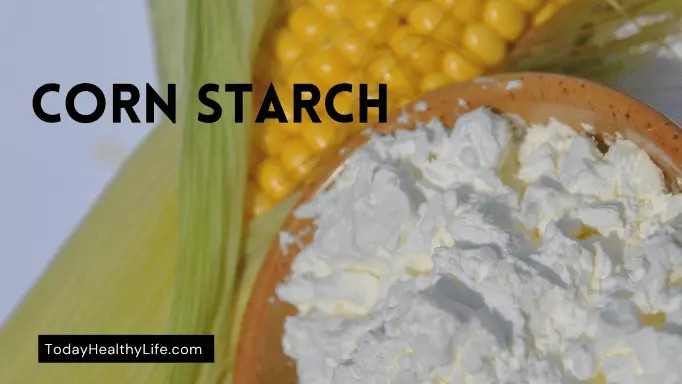Wheat starch is one of the most common ingredients in your kitchen.
Though there are many other starches and flours, wheat starch is still in demand for a lot of reasons.
Here, we’ll discuss what wheat starch is, its calorie count and nutrition facts, its uses, benefits, probable side effects, their substitutes, modified wheat starch, the answer to whether wheat starch is gluten-free or not along with the answers of some other frequently asked questions.

Table of Contents
What is wheat starch?
Wheat starch is the starch made from wheat kernels. This is basically a plant-based carbohydrate. You’ll need to grind wheat kernels, separate the ground wheat, remove the gluten and refine the starch more to make it into wheat starch.
Wheat starch is the gluten-free version of flour. You can cook and bake many foods with them, but with fewer risks. We see a good carb in starch.
Wheat starch is just like any other starch, good for thickening and baking. And easy to find in your local grocery shops as well.
Also Read:
- What is corn starch: calories, nutrition, all uses, substitute idea.
- What is corn flour– nutrition, benefits, substitute, is it gluten free?
- Is corn starch gluten-free? Why do females eat it, & more
- Cornstarch vs cornflour: all you need to know to compare.
- What is Kamut flour? benefits, is it gluten-free? nutrition & all.
Is wheat starch gluten free?
Wheat starch is generally considered gluten-free, but it is important to note that there is a small amount of gluten that can remain in the starch after processing.
The FDA allows wheat starch to be included in gluten-free labeled products as long as the final product contains less than 20 parts per million (ppm) of gluten.
This means that people with celiac disease or gluten intolerance can safely consume wheat starch that is labeled gluten-free.
However, it is important to note that not all wheat starch is created equal. Some wheat starches may contain higher levels of gluten than others, so it is important to read food labels carefully and only consume wheat starch that is labeled gluten-free.
Additionally, it is important to note that wheat starch can cross-contaminate with gluten if it is not processed properly.
Therefore, it is important to only purchase wheat starch from reputable companies that have a good track record of producing gluten-free products.
Calorie count of wheat starch
There are 351 calories in 100 grams of wheat starch. This means that a 1-ounce serving of wheat starch (28 grams) contains about 98 calories.
Wheat starch is a good source of carbohydrates, providing about 94 grams per 100 grams.
It is also a good source of fiber, providing about 2 grams per 100 grams. Wheat starch is low in fat and protein.
Here is a table of the calorie content of wheat starch in different serving sizes:
| Serving Size | Calories |
|---|---|
| 1 ounce (28 grams) | 98 |
| 1/4 cup (56 grams) | 195 |
| 1/2 cup (112 grams) | 390 |
| 1 cup (160 grams) | 561 |
As you can see, the calorie content of wheat starch is relatively high. This is because wheat starch is a concentrated source of carbohydrates.
If you are trying to lose weight or maintain a healthy weight, it is important to be aware of the calorie content of wheat starch and to consume it in moderation.
Nutrition values of wheat starch
Let us remind you, as a pure carb, wheat starch does not contain many nutrition facts.
But, whatever they contain, can be helpful if you know how to create the proper diet plan.
Let’s take a look at the nutritional values of wheat starch.
- As a pure carb type food item, it is only natural that wheat starch will have a huge amount of carbohydrates. Every 100 grams of wheat starch contains 85 grams of carbohydrates. The number is huge, and carbs are helpful for energy-boosting. Wheat starch itself is energy-boosting we might say at this point.
- As a gluten-free item, wheat starch does not contain much protein. Though they still have a small amount of protein in them. Every 100 grams of wheat starch can provide you with 530 mg of protein. The key element for muscle health.
- People usually consider fats as a bad element, which is partially true. But, there are the good fats (not the trans ones) which you actually need in a small amount to keep good health. Every 100 grams of wheat starch contains 150 mg of fats, not a single bit of them are trans fat, so don’t worry.
- Carb-type foods, especially grainy ones contain a good amount of fibers. To be more specific, fiber-enriched carbs are the better carbs. And wheat starch has them. Every 100 grams of wheat starch contains 240 mg of fibers.
- Though wheat starch does not contain any vitamins or minerals, there is one exception. That is calcium. Wheat starch contains calcium, the element responsible for bone health. Every 100 grams of wheat starch contains 15 mg of calcium. The amount is not that small either.
Those were the core nutritional values you can get from wheat starch.
Moving to the next section, we’ll discuss the modified wheat starch.
Also read: Brown rice flour: Nutrition, benefits, substitute, how to make, etc.
Modified wheat starch
Modified wheat starch is the modified version where it has 75% of resistant starch. The modification process includes turning the starch into a resistant type, removing the last bit of gluten, and making it with lower-calorie to decrease the number of carbs.
You can find modified wheat starches in the super shops easily, and these days, they are growing more and more popular. Hence, a lot of grocery shops have them too.
Uses of wheat starch
Wheat starch has its best uses in the kitchen. They are good for both baking and thickening.
Though, apart from the kitchen jobs, they have some other impressive uses as well.
Let’s take a look.
- The common use of wheat starch is in foods. You can use them to thicken the soup you’re cooking, maybe you have already used it for a while now!
- Starches are a mandatory ingredient to make pasta and spaghetti sauce. Wheat starch too can be really great in making sauces.
- Not only sauce, but wheat starch is also the key ingredient to make pasta and noodles type food items.
- Even though wheat starch is sugar-free, you’ll still need them to make syrups.
- In most Chinese foods, wheat starch can amazingly enhance the texture.
- Wheat starch has another amazing use in the kitchen apart from the thickening jobs. They are really great for baking. Be it cakes or loaves of bread, wheat starch is amazing!
- It has some other surprising uses as well. The paste of wheat starch is helpful for all sorts of skin irritations, and bug bites.
- If you run out of deodorant, you can use wheat starch, coconut oil, and baking soda to make deodorant at home! They are refreshing, and moisturizing at the same time.
- Another brilliant use of wheat starch comes when you run out of dry shampoo. Well, that is true for most kinds of starches. But, as they are usually white (and yellowish sometimes), using them in dark-colored hair will be a drag. The dry shampoo usage is exclusive for blondes only.
- If you’re facing a hard time ironing clothes- especially the silky ones, you can sprinkle some wheat starches over the clothes before you start ironing.
Is wheat starch healthy? & Benefits
Carb-type foods are usually a must in your daily meals unless you’re doing a keto diet.
Wheat starch hence is an essential part of many people’s daily lives.
Let’s take a look at the beneficial sides of this popular carb.
- High in calories and carbs, wheat starch is really helpful to keep you energetic.
- Carbohydrate is a mandatory element for the growing period of a child. Wheat starch has a variety of usages. Pasta, spaghetti, and noodles are some food items that the children love to eat- thus, wheat starch is helping the children meet their daily need for carbs.
- Their ability to provide skin relief is another beneficial side that you’ll need often.
- As wheat starch has a good amount of calcium as well, they are really beneficial for both your bones and teeth.
- Hope you remember that wheat starch is gluten-free? Well, gluten-free ingredients are the best and most beneficial carbs for people with celiac diseases.
- Apart from the kitchen jobs, wheat starch is beneficial for some other household chores as well- like helping in ironing clothes, providing good odors on insides, etc.
More than just food, right?
Wheat starch substitute
Wheat starch is an important ingredient in the kitchen.
But what if you’re running out of wheat starch and can’t find any in the local shops either?
What if in that time of scarcity you’re in urgent need to cook some starchy foods?
Don’t worry. Wheat starch has some common substitutes that you’ll be able to use regardless.
Let’s take a look.
Wheat flour

Wheat flour is almost the same as wheat starch, except for the fact that wheat flour contains gluten. So, you can use wheat flour as a substitute only if the people who will eat the food do not have celiac disease.
Corn flour

Corn flour is another popular and easy-to-find substitute for wheat starch. Their usages are pretty similar too! But again, they too contain gluten.
All-purpose flour
All-purpose flour is another substitute for wheat starch, but they too contain gluten.
Cornstarch

Cornstarch meanwhile is the most perfect substitute for wheat starch that is gluten-free as well. Their thickening ability is just as fine as wheat starch too!
Potato starch
You can use potato starch as a substitute too, but only as a thickening ingredient. This one is gluten-free too. The only problem is, that they are not the perfect option for baking.
And guess what? All of these substitutes are available at most places.
Also read: – What is rice flour, how to make rice flour, is rice flour gluten free? substitute & all.
Probable side effects of wheat starch
Nothing comes flawlessly. Nor even wheat starch. They too have some probable side effects just like any other food item. Let’s take a look.
- Wheat starch is high in carbs. That means, if you over-consume it, you might get a sudden weight gain.
- Some people are allergic to wheat. If they consume wheat starch, it might trigger allergic reactions to them.
- Another big risk comes from overconsumption. The risks of constipation if you overeat baked wheat starch.
So, you need to eat balanced food to avoid any health risks.
On the other hand, modified wheat starch’s side effects generally can be the same as normal wheat starch. It actually depends on how wheat starch is modified, and which ingredients are used while modifying.
Frequently asked questions
People often ask questions regarding wheat starch. In this section, we’ll be providing the answers to those questions.
The answer is no. Wheat starch is mostly carbs, and keto is the “no-carb” diet. Wheat starch is not keto.
People who have a disease named “Pica” eat plain wheat starch. The reason behind Pica is mineral deficiency, and it’s curable. Don’t worry.
No. Wheat flour and wheat starch- both are ground wheat. But, wheat starch is gluten-free whereas wheat flour contains gluten.
Wheat starch has a good amount of fibers and has no sugar. So, as long as you are not overconsuming it, they will be fine in diabetes.
Conclusion
Here was it all. We hope that the information we’ve provided about wheat starch here will be of help to you.
And now, if you have any further questions, don’t hesitate to write them down in the comment box below.
And lastly, let us remind you once again, for any kind of medical emergency or trouble, please do consult a doctor.
Eat healthy, live healthy!

Thank you for your article. Very informative. I came across it because I looked up modified wheat starch. My husband eats tortilla wraps that are low carb and (he says) helps with his weight control. He’s been adding weight since he’s been eating one or two of these per day. He originally lost weight for 2 years by eating lots of vegetables and non processed foods.
So..will you please inform me if you know of any health disadvantages to modified wheat starch? Thank you.
Hi, thanks for your comment. I mentioned it in the same post. Please check that out again in the side effects section.